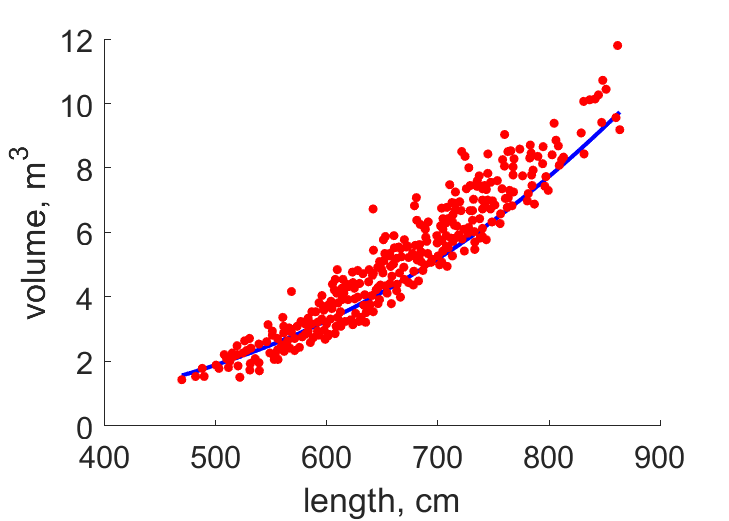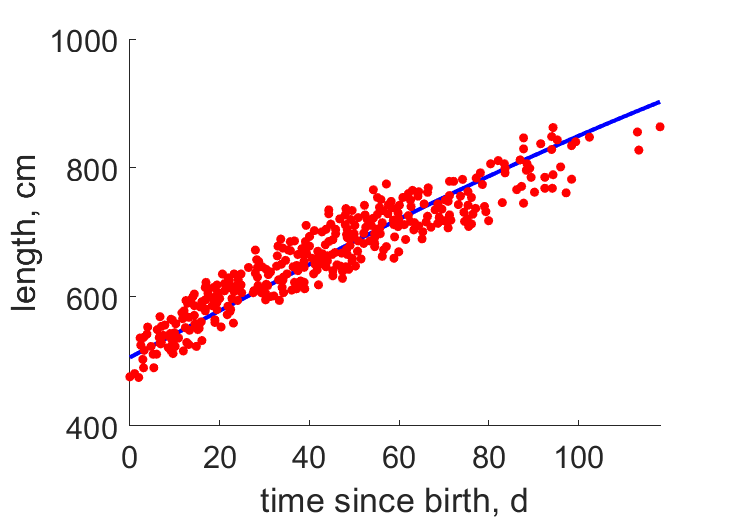Predictions & Data for this entry
| Model: stx | climate: ME | migrate: Ml | phylum: |
| COMPLETE = 2.5 | ecozone: MS | food: bxM, xiCik | class: |
| MRE = 0.037 | habitat: 0iMp | gender: Dg | order: |
| SMSE = 0.004 | embryo: Mv | reprod: O | family: |
Zero-variate data
| Data | Observed | Predicted | (RE) | Unit | Description | Reference |
|---|---|---|---|---|---|---|
| tg | 365 | 368.6 | (0.009851) | d | gestation time | AnAge |
| tx | 167.8 | 167.3 | (0.002924) | d | time since birth at weaning | ADW |
| tp | 3650 | 3673 | (0.00629) | d | time since birth at puberty | ADW |
| am | 3.65e+04 | 3.642e+04 | (0.002292) | d | life span | Wiki |
| Lb | 500 | 506.1 | (0.01225) | cm | length at birth | ChriVivi2018 |
| Li | 1640 | 1524 | (0.07085) | cm | ultimate length for females | Wiki |
| Lim | 1500 | 1501 | (0.0007146) | cm | ultimate length for males | Wiki |
| Wwb | 2e+06 | 1.959e+06 | (0.02055) | g | wet weight at birth | ChriVivi2018 |
| Wwi | 4.7e+07 | 5.346e+07 | (0.1374) | g | ultimate wet weight | Wiki |
| Ri | 0.0009132 | 0.0009093 | (0.004334) | #/d | maximum reprod rate | AnAge |
Uni- and bivariate data
| Data | Figure | Independent variable | Dependent variable | (RE) | Reference |
|---|---|---|---|---|---|
| LV |  | length | volume | (0.1231) | ChriVivi2018 |
| tL |  | time since birth | length | (0.03682) | ChriVivi2018 |
Pseudo-data at Tref = 20°C
| Data | Generalised animal | Eubalaena australis | Unit | Description |
|---|---|---|---|---|
| v | 0.02 | 0.1025 | cm/d | energy conductance |
| p_M | 18 | 24.6 | J/d.cm^3 | vol-spec som maint |
| k_J | 0.002 | 0.002 | 1/d | maturity maint rate coefficient |
| k | 0.3 | 0.6379 | - | maintenance ratio |
| kap | 0.8 | 0.8399 | - | allocation fraction to soma |
| kap_G | 0.8 | 0.7998 | - | growth efficiency |
| kap_R | 0.95 | 0.95 | - | reproduction efficiency |
Discussion
- Males are assumed to differ from females by {p_Am} only
- Growth between birth and weaning could only be captured with a larger energy conductance, else the max assim rate would become very large
Bibliography